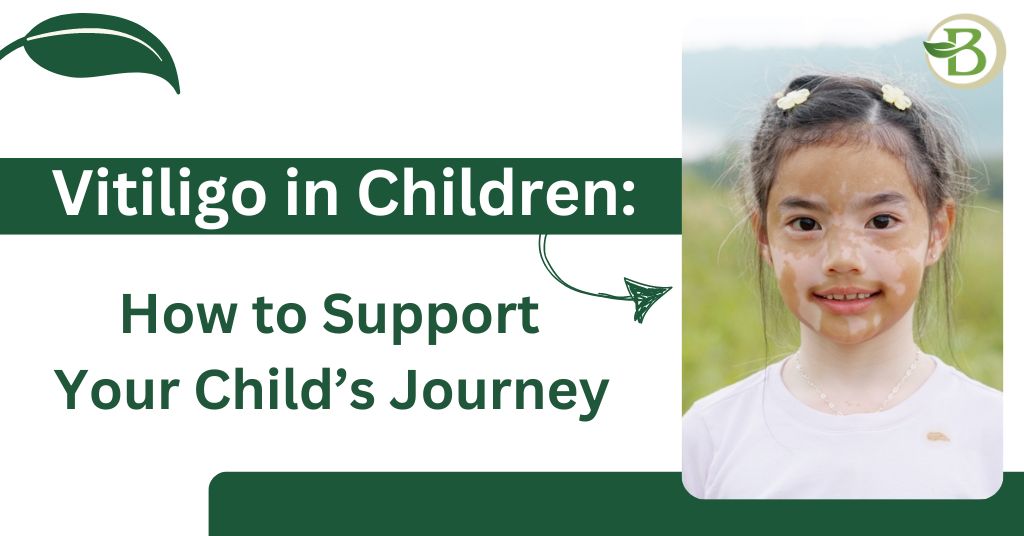Understanding Vitiligo
Vitiligo occurs when the melanocytes, the cells responsible for skin pigmentation, are destroyed, leading to the development of depigmented patches on the skin. It causes problems for people of all ages, but when it affects children, it presents special difficulties for the children and their parents. Can vitiligo spread? Vitiligo is not contagious and is not considered painful; however, the psychological impact can be significant, especially for children who are still developing their self-esteem and identity. Encouraging a child with vitiligo entails meeting their physical, emotional, and social needs and helping them develop a positive self-image.
Let me walk you through the journey of a child’s parent to help you better comprehend it.
As a parent, I’ve always been worried about his school experience, says Srishti’s father, a child suffering from vitiligo. On the other hand, Anshika’s father, another vitiligo patient, was found to be worried about how other kids would treat him and whether she’d be able to accept herself as the amazing and attractive person that she is. She further adds, I am completely aware of the moments when individuals, perhaps unintentionally, fix their bewildered gaze on their white patches on skin. When a youngster who could have been standing near her abruptly steps away out of confusion, I notice it. All of these things, of course, affect me because I’m concerned about what effect they will have on my child once he starts to realize why this is all happening!
Therefore, we decided that our child needed to know that they are not alone in their experiences. Vitiligo contributes to one’s identity in the same manner as other factors such as height, eye colour, hair colour, and other traits do. All of these forced us to undergo counselling sessions that helped motivate us and our children in this healing journey.
The following factors can be considered and may prove beneficial in dealing with a child struggling with vitiligo.
Emotional Support
- Open Communication: Encourage your child to openly communicate their feelings regarding their situation. Pay attention to what they are saying and respect their emotions. Establish a safe environment in which individuals may freely express their concerns and experiences.
- Education: Educate your child about vitiligo in an age-appropriate manner. Understanding their condition can help demystify it and reduce fear. Use resources like books and informative videos designed for children to explain vitiligo in a relatable way.
- Building Self-Esteem: Focus on your child’s strengths and talents. Encourage activities that they enjoy and excel in to build confidence. Reinforce the idea that their worth is not determined by their appearance.
- Counselling: Consider professional counselling or support groups for your child. Speaking with a therapist who specializes in pediatric dermatology or childhood emotional health can provide valuable strategies and a sense of being heard.
Social Support
- Peergroup Interaction: Facilitate opportunities for your child to interact with peers in various settings. Encourage friendships and participation in group activities, as these can help them feel included and supported.
- School Environment: Work with your child’s school to ensure they are aware of your child’s condition. Educate teachers and staff about vitiligo and its implications to foster a supportive environment. This can include addressing any instances of bullying or teasing promptly and effectively.
- Role Models: Introduce your child to role models who have vitiligo. Seeing public figures or community members living confidently with vitiligo can inspire your child and provide a sense of belonging.
- Awareness Campaigns: Engage in or support awareness campaigns about vitiligo. This can help reduce stigma and increase acceptance within the community, benefiting your child and others with the condition.
Physical Support
- Healthy Lifestyle: Encourage a healthy lifestyle with a balanced and proper diet routine, regular exercise, and adequate sleep. A strong immune system can help manage overall health, which might have a positive impact on vitiligo management.
- Skin Care: Develop a gentle skincare routine. Use mild, fragrance-free natural products(as prescribed by a dermatologist) to avoid irritation. Moisturize regularly to keep the skin hydrated and reduce any discomfort.
Building a Positive Environment
- Inclusive Family Activities: Engage in activities that promote family bonding and inclusivity. Whether it’s a hobby, sports, or arts and crafts, participating in enjoyable activities together can help your child feel supported and cherished.
- Education and Advocacy: Advocate for vitiligo awareness in your community. Educate friends, relatives, and neighbours to foster a supportive network. This can reduce misunderstandings and promote a more inclusive environment for your child.
- Adaptation and Flexibility: Be flexible and adapt your support strategies as your child grows. Their needs and challenges will evolve, so staying attuned to these changes and adjusting your approach accordingly is essential.
Bharat Homeopathy: Best Homeopathic Treatment For Vitiligo
With its specially formulated vitiligo medication, homeopathy aids in strengthening the body’s defence systems and is considered one of the most reliable treatment options for vitiligo. Before prescribing homeopathic treatment for vitiligo, a detailed analysis of the patient’s medical history is done. When creating a vitiligo homeopathic treatment plan, all aspects of the illness, mental, emotional, and physical, are taken into account. When developing customised homeopathic medicine for vitiligo patients, Bharat Homeopathy takes into consideration all necessary procedural precautions. Our treatment regimen is absolutely devoid of side effects, and this has helped us develop an outstanding track record in the medical field.
Conclusion
Supporting a child with vitiligo involves a holistic approach that encompasses emotional, social, and physical aspects. By fostering open communication, building self-esteem, promoting social interactions, ensuring proper medical care, and creating a positive environment, you can help your child navigate their treatment for white spot on skin journey with confidence and resilience. Remember, your support and understanding are the pillars that will help your child thrive despite the challenges of vitiligo.


